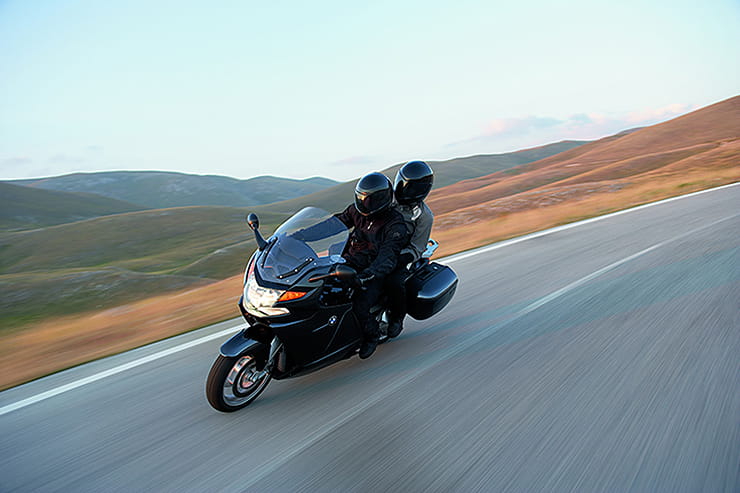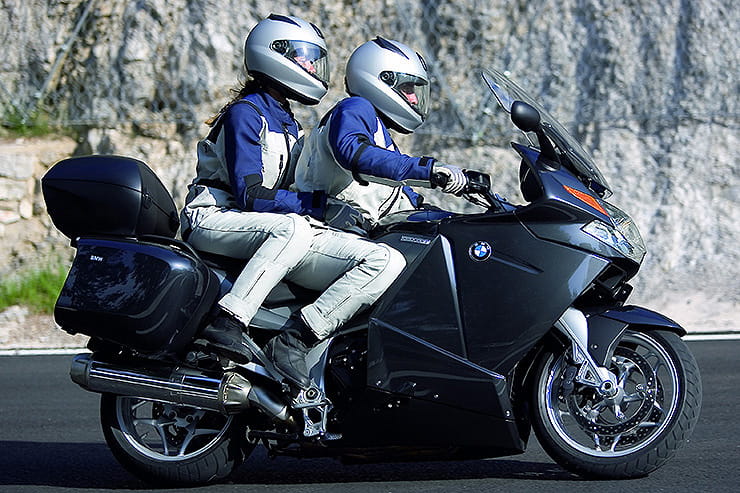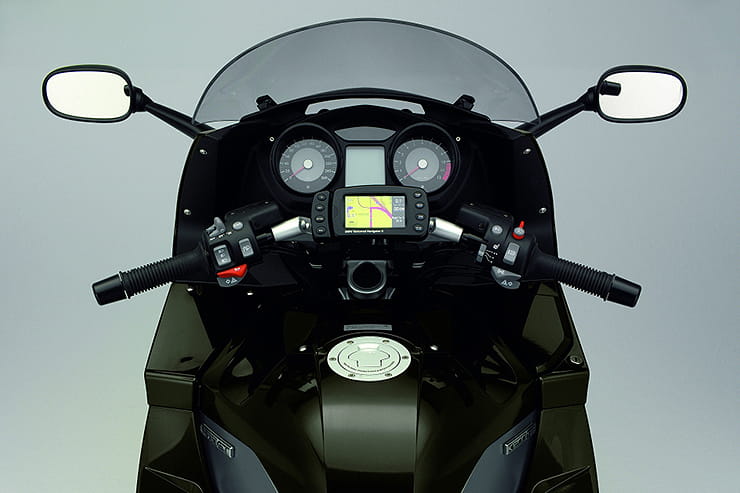
Price: £3000-£5000 | Power: 152bhp | Weight: 249kg | Overall BikeSocial Rating: 3/5
Billed by BMW as the ‘ultimate First Class long-distance tourer’, which they claimed was perfect for a lunch meeting in Barcelona followed by a dinner date in Milan (609 miles if you are interested, so you would have to push on a bit!), the K1200GT is an overlooked model in the German firm’s range. Effectively a K1200S (which was all-new in 2005) with a bigger fairing and a few more creature comforts, the GT (Gran Turismo) version took over from the older K1200GT model in 2006 and brought with it the very latest in tech from BMW including the option of ESA and ABS as standard. Like so many first-generation models, it does suffer from a few annoying teething issues but these aside it is a fast, comfortable and solid-handling tourer that is extremely good at smashing out miles with minimal hassle. And when you look at its used price tag it is quite tempting as you are certainly getting a lot of very fast metal for your money.
BMW K1200GT (2006-2008) Price
The GT cost a slightly eye-watering £11,995 in 2006, which was quite a chunk of cash. And that was before you started to tick the official BMW accessories box, which was naturally fairly extensive... Nowadays the GT’s unpopularity sees examples go for as little as £2500 – although there is a catch. As this is a bike built for covering big miles, any machine at this price point will have done exactly that and you need to expect a mileage in the 50,000 miles area. Up your budget to just over £3000 and the mileage drops into the 30,000 area and pay closer to £4500 and you can get a 2007 model with 20,000 miles on its clocks. When you look at the cost new and the price for a used one, paying £4500 isn’t that bad value at all.
Pros & Cons
- Amazing engine with bags of power
- Great mile-munching ability
- Surprisingly low price tag
- Reliability can be a slight worry
- It’s quite heavy at low speed
- Parts will be starting to wear out by now

Engine and Performance
It is very important not to confuse the old K1200GT with the new 2006 K1200GT – they are two very different bikes. The 2006 model is all-new (well, the K1200 platform it is based around is all-new) and where the old GT makes 130bhp, the new one makes 152bhp and has much more tech. Unveiled on the S model (which was technically a 2005 model but was delayed in production due to fuel-injection issues) the 1200 motor is an inline four (fitted crosswise where the old model was longitudinally) which was designed as a ground-up new motor to power a whole new generation of K-Series models. Taking tech from BMW’s car and F1 side, it is both very narrow and extremely powerful, something that made the S hyperbike version a genuine rival for the Hayabusa. In GT format BMW have cut its performance slightly from the S model’s 167bhp to 152bhp but it retains the same 130Nm of torque and that’s what really counts on a tourer.
Absolutely brimming with torque and with a shaft drive to make maintenance as easy as possible, the K-Series engine is hard to fault and although the fuel-injection system is a bit basic, it’s not horrific. Owners absolutely love the smoothness and flexibility you get from such a big-capacity motor and report it is as happy bimbling around at 30mph as it is going flat-out on an Autobahn. That’s the good news, the bad news is that it does suffer from a few issues that you need to be aware of in the used market.
The shaft drive system is fairly robust but high mileage does see it start to require replacement parts and that’s when it can get expensive. A BMW specialist will charge about £400 to rebuild one that requires it so look for any signs of oil leaks and listen for any grumbles that indicate the bearings require replacement. Speaking of noises...
When started from cold the K1200 engine is very agricultural and rattly – they all are, that’s not a worry and is mainly down to the cam chain tensioner requiring oil pressure to build up. If it bothers you, you can fit a K1300 tensioner to reduce the noise as it is a better designed unit. The clutch also rattles like hell and slams into first gear with a heck of a clunk but again, they all do that. That said, always check the gears engage nicely as gearbox are known to go, especially if an aftermarket quickshifter is fitted (it is only on the K1300 model that BMW made a shifter for the bike). Always give the radiator a very good check for leaks and excessive corrosion (if the fans come on in stationary traffic, treat this as a warning sign of it being clogged up with crud) as a new unit is over £500 and they are quite prone to going, especially on a bike used all year long, and watch out for the bike’s service history. The GT requires its valve clearances checked every 18,000 miles, which is a tricky job that requires the radiator to be removed to gain access to the front of the motor and that means about £600 in labour. And quite often they will need altering, which adds even more to the bill. These are the major worries but owners do report the level of finish on the engine itself is poor, so have a good look behind the fairing for corrosion, and sensors fail, so watch out for any fault codes on the dash. Overall, if well looked after, mechanically it is fairly sound.

BMW K1200GT (2006-2008) Handling & Suspension
A quirk of the K-Series bikes is BMW’s uses of a Duolever front end. A take on the system created by Norman Hossack, it is claimed to give better feel and remove any ‘fork dive’ to give a more consistent feedback. Some riders like it, others don’t, but on a big tourer as fast as the GT, it does make a lot of sense and does feel quite at home. When up to speed the GT is perfectly stable and although not the most agile of machines due to a long wheelbase and quite conservative geometry, it is happy to corner at a relaxed pace. Owners comment that at low speed the 249kg BMW does feel 249kg, but that is kind of to be expected and with a seat height of just 800mm your feet are pleasingly and reassuringly close to the floor. When buying used, you need to check for play in the Duolever system’s ball joints as getting it rebuilt is about £500. The best way to inspect it is to get the front in the air (never pivot it up using the side stand, always the centre stand as the side stand is quite fragile) and feel for play but also ride at 30mph on a smooth and straight piece of road and feel for a gentle weave. Now onto the suspension...
The K1200S was the first BMW to come ESA (Electronic Suspension Adjustment) and this was also a £525 option on the GT. Not semi-active and only applicable to the shock, ESA allows the rider to alter the damping while on the go via the dash to Comfort, Normal or Sports settings and also the spring’s preload when stationary to either Solo, Solo with luggage or Rider, passenger and luggage. Not the most technically advanced of systems, it is nonetheless a good thing to have fitted as it does enhance the ride quality – as long as it is working! By now a fair few ESA units are giving up the ghost and as they can’t (technically, a few companies will give it a go) be rebuilt you are talking a whole new shock at about £700. Or you will have to replace it with a non-ESA unit and ignore the fault code (or buy a plug-in dongle to remove it) on the dash!

Comfort & Economy
The K1200GT isn’t the most economical of bikes and you need to expect roughly 40mpg on a good day. BMW did claim 50mpg was achievable but that’s not very realistic. That said, the GT’s big 24-litre (up 5 litres on the S) means that you have a tank range of approaching 300 miles. Possibly even exceeding it. And given its comfort levels, you might well be tempted to do this!
Thanks to an electronically-adjustable screen (always check it works, the motors can break), large fairing and relaxed seating position (the bars can be moved up/down by 40mm) the GT does exactly what it promises and can certainly allow you to cover big distances in comfort. Even more so if you get a bike with the optional extra cruise control and heated grips and seat fitted. BMW also offered a Xenon headlight and the option of Tyre Pressure Monitors as well as an upgraded onboard computer but these are less common in the used market.

BMW K1200GT (2006-2008) Equipment
Most GTs were sold in a very high spec and you got colour-coded panniers as standard as well as ABS so very few owners add much more – aside from miles! As discussed in the Comfort section, cruise control, heated grips and seat and ESA are welcome additions to any used bike and a lot of owners add a taller screen and also sometimes a top box. When buying used, always check the immobiliser works as a lot of K1200 modes suffer from broken antenna, which renders the bike unable to see the fob, leaving you stranded. Early bikes also had lots of issue with switchgear packing up due to water ingress, so ensure all is well here as replacements are quite pricey.
BMW K1200GT (2006-2008) Rivals
The market for hyper bikes is very small and the market for hyper GT tourers even smaller, so the GT is a tricky bike for dealers to off-load and therefore prices are pleasingly low. Generally owners are the kind of buyer who appreciates the GT for the bargain it is, are happy to do a bit of work on it themselves, like to cover big miles and are old enough to ensure such a fast bike!
Yamaha FJR1300 (2001-2020) | Approx Price: £3000-£11,500
Power/Torque: 144bhp/102lb-ft | Weight: 292kg
Honda VFR1200F (2010-2017) | Approx Price: £3500-£8000
Power/Torque: 170bhp/95lb-ft | Weight: 267kg
Kawasaki GTR1400 (2007-2015) | Approx Price: £4000 - £8500
Power/Torque: 139bhp/94lb-ft | Weight: 304kg

BMW K1200GT (2006-2008) Verdict
The K1200GT is an over-looked model in BMW’s range as dedicated mile-munchers tend to opt for either the RT or even the sportier K1200S, which is undeniably better looking than the GT. However if you are after a no-hassle machine for either a long commute or European tour the GT is a good option. If you can afford it the updated K1300GT is not only more refined but also more reliable, so is a better overall buy, but if your budget is tight and you are prepared to take a bit of a risk on things possibly going wrong the K1200GT will certainly hit the mark.

BMW K1200GT (2006-2008) - Technical Specification
|
Original price
|
£11,995
|
|
Current price range
|
£3000 - £5000
|
|
Capacity
|
1157cc
|
|
Bore x Stroke
|
79.0mm x 59.0mm
|
|
Engine layout
|
Inline four
|
|
Engine details
|
Liquid-cooled, DOHC, 16-valve
|
|
Power
|
152bhp (110kW) @ 9500rpm
|
|
Torque
|
95lb-ft (130Nm) @ 7750rpm
|
|
Top speed
|
165mph
|
|
Transmission
|
6-speed, shaft final drive
|
|
Average fuel consumption
|
40mpg
|
|
Tank size
|
24-litres
|
|
Max range to empty (theoretical)
|
300 miles
|
|
Reserve capacity
|
37 miles
|
|
Rider aids
|
ABS, optional ESA
|
|
Frame
|
Aluminium twin spar
|
|
Front suspension
|
BMW Duolever
|
|
Front suspension adjustment
|
None
|
|
Rear suspension
|
BMW Paralever, monoshock
|
|
Rear suspension adjustment
|
Fully-adjustable, optional ESA
|
|
Front brake
|
320mm discs, four-piston calipers. ABS
|
|
Rear brake
|
265mm disc, two-piston caliper. ABS
|
|
Front tyre
|
120/70 ZR17
|
|
Rear tyre
|
190/50 ZR17
|
|
Rake/Trail
|
29-degrees / 101mm
|
|
Dimensions (LxWxH)
|
2318mm x n/a x n/a
|
|
Wheelbase
|
1577mm
|
|
Ground clearance
|
n/a
|
|
Seat height
|
800mm
|
|
Kerb weight
|
249Kg Wet
|
Looking for motorcycle insurance? Get a quote for this motorbike with Bennetts bike insurance








.ashx?h=493&w=740&la=en&hash=9C1E3BD045D423927A83C2F1931ED45FC8607893)






